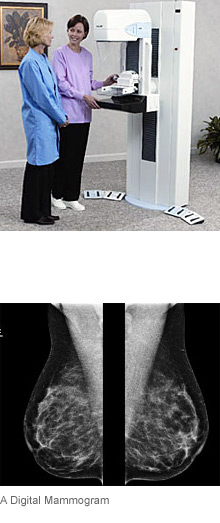3D Digital Mammogram

3D Digital Mammogram
Peninsula Diagnostic Imaging was the first facility in Northern California to provide 3D Mammography.
Screening for Breast Cancer
Doctors and scientists agree that early detection is the best defense against breast cancer. If we find cancer in its earliest stages, the chances of surviving it are good. Until now, the best way to do that has been with digital mammography.
While digital mammography is still one of the most advanced technologies available today, it is only a two-dimensional picture of the breast. Since the breast is composed of pockets of dense tissue surrounded by fat, when x-rayed, it creates an image that looks something like a smoky haze. The overlapping tissues in the image make it difficult to see tiny “spots”, or masses, and other subtle signs of early cancer.
A New, Superior Screening Tool
For decades doctors have been searching for a technology to help them find very small cancers and eliminate “false positives” in order to reduce the number of women who are called back from screening for diagnostic mammography.
Scientists have developed a new technology called breast tomosynthesis, which has been shown in clinical studies to be superior to digital mammography both in finding small cancers and reducing the number of women called back from screening mammography.
Breast tomosynthesis (3D mammography) allows doctors to examine breast tissue one layer at a time. This technology has been recently FDA approved and is now available at Peninsula Diagnostic Imaging. Breast tomosynthesis is a new technology in the fight against breast cancer. Breast tomosynthesis is used in conjunction with traditional digital mammography as part of your annual screening mammogram to capture more detailed breast images. Very low X-ray energy is used during the screening examination so your radiation exposure is safely below the American College of Radiology (ACR) guidelines. Using breast tomosynthesis and digital mammography together for screening has been proven to reduce “call-backs”.
3-D Digital Screening Mammogram
A mammogram is a low-dose X-ray of the breast, used to screen for abnormal changes in breast tissue, including cancer. A screening mammogram is the most commonly performed examination. This type of mammogram is for women with no known breast problems and is used to look for abnormalities in the breasts.
3-D Digital Diagnostic Mammogram
A diagnostic mammogram is for women who have concerns about a new lump, new nipple discharge, or other breast problems that need evaluation.
A diagnostic mammogram may also be a “call back” or “second-look” mammogram where our radiologist may see something on your screening mammogram that requires further evaluation.
How is a 3-D screening or diagnostic mammogram performed?
A certified 3-D mammography technologist will position you in our state-of-the-art 3-D mammography machine. Your breast will be placed between two plates and gently compressed, so that as much of your breast and surrounding tissue as possible can be visualized on the X-ray. During the 3D portion of the examination, the x-ray arm of the mammography machine makes a quick arc over the breast; this will only take a few seconds. Compression may cause some mild discomfort, so it is best to schedule your test one – two weeks following your period. Two views are taken of each breast.
Preparation for Exam
Avoid the use of powders and deodorants that morning, if possible, because they leave a residue that can be mistaken on a mammogram for calcifications, which may require a second-look, or diagnostic, mammogram. It is best to wear a two-piece outfit because the procedure requires you to remove clothing above the waist.
Frequently Asked Questions (FAQ)
- What is 3-D digital mammography?
- Who should have a screening mammogram?
- Does a screening mammogram find all breast cancers present?
- Is a mammogram painful?
- Why might I be called back for a diagnostic mammogram?
- How is a diagnostic mammogram different from a screening mammogram?
- What to expect during your exam
